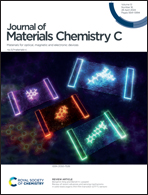Enhanced stability and tunable optoelectronic properties of silicon–carbon monolayers by strain and surface functionalization†
Abstract
Exploring novel two-dimensional carbon-based materials with superior properties is of special importance for applications in nano-optoelectronics. Here, based on theoretical calculations, a silicon–carbon (Si2C) monolayer is explored, offering desirable properties with strain and surface functionalization. The pristine Si2C monolayer is dynamically unstable, but a small tensile strain of +2.5% and fluorination can make it more dynamically stable. The pristine Si2C monolayer is a direct semiconductor with a moderate bandgap, whose gap and exciton binding energy can be continuously tuned by strain engineering. Also, the tensile strain (fluorination) on the Si2C monolayer can induce a variation in optical transitions, thus resulting in a significant red-shift (blue-shift) of the optical absorption spectrum. In short, the Si2C monolayer under tensile strain and fluorination is unique, making it a promising candidate for nano-optoelectronics.

- This article is part of the themed collections: 2024 Journal of Materials Chemistry C Most Popular Articles, 2025 Journal of Materials Chemistry C Chinese New Year collection and 2025 Journal of Materials Chemistry C Lunar New Year collection


 Please wait while we load your content...
Please wait while we load your content...